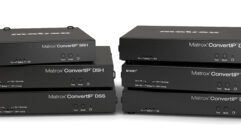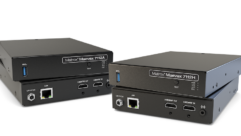
Technology Showcase: Web Video Streaming Gear
May 6, 2009 12:00 PM,
By Bennett Liles
Sending video to the Web has become push-button easy.

Digital Rapids TouchStream
Long gone are the days when only the largest companies, churches, and universities could afford to get video and sound out to the world. All of these entities have a need to get the word out, but with the emergence of small, portable web-streaming appliances has come what some have called a democratization of information. Using the Internet as a worldwide broadcast network, even individuals can become global broadcasters or narrow¬casters, and this has had a profound effect on both content producers and viewers. Let’s have a look at some of the current offerings in this dynamic market.
Billed as an appliance that turns any room into a webcast studio, the AccordentCapture Station includes video and VGA capture cards to input all the various elements consisting of audio, video, and graphics and seamlessly synchronizes them into one complete presentation. Laptops, projectors, smartboards, and document cameras can be connected to the unit. The user simply clicks Start, and the system will capture, record, and synchronize all the presentation sources. The resulting combined file can be streamed live to the Internet or an intranet, and it can be recorded and posted for viewing on demand. Pre-installed editing software enables the user to review and edit each element of the presentation including adding or cutting images and adjusting presentation timing. Viewers can receive the presentations with Windows Media Player, RealPlayer, MP3 players, and a range of browsers.
For simplicity, portability, and ease of use, the Webcast in a Box from Box Populi is hard to beat. The device allows the user to encode and stream a combined file consisting of video from a camera and video from a computer display. Beyond that, the background may be customized with a specific color, image, banner, or logo and viewed with RealPlayer. The hardware has composite and S-Video jacks for video input, and the network connection is labeled “1GB.” It can interface at network bit rates of 1Gbps, 100Mbps, and 10Mbps. The device can be operated by simply plugging in a USB key to start the webcast and removing it to stop the presentation. The unit displays its IP address in the LCD window on the front panel. Anyone with a browser on the same network just types that IP address into the URL window of the browser to view the webcast.
An integrated component of the CiscoDigital Media System (DMS), the Cisco Digital Media Encoder 1000 provides live and on-demand digital streaming media with video and sound on any IP network, and it can also be used as a standalone unit. The front-panel buttons allow users to select between a number of predesignated Windows Media and MPEG4/H.264 encoding profiles. On-demand formats supported include these and Flash. The unit’s physical interfaces include both composite and S-Video connections along with RCA and XLR connections for audio. There is also a front-panel dock for downloading directly to an Apple iPod. The Cisco Digital Media Manager can set up and control multiple media encoders such as the Media Encoder 1000, schedule live streaming events, and publish live and on-demand streaming presentations.
The Webcaster-3 from Communitek Video Systems is packaged in a tough road rack, and it includes every¬thing needed to input audio and video signals and output an IP network signal in up to three simultaneous streams, depending on which build option is selected at purchase. While performing live streaming, the unit can simultaneously record an archive file to the internal hard drive for on-demand viewing as well as onto an onboard DVD recorder as a removable backup. Synchronized PowerPoint presentations can be assembled using third-party PowerPoint push software such as sofTV.net or Encoder Script. The unit can be connected to a small video switcher for mobile webcast production.
Technology Showcase: Web Video Streaming Gear
May 6, 2009 12:00 PM,
By Bennett Liles
Sending video to the Web has become push-button easy.
The incredibly simple front-panel layout of the new TouchStream web-streaming appliance from Digital Rapids belies its operational versatility in an easy-to-deploy form factor. The unit uses the same video-preprocessing capability as the other streaming encoders from Digital Rapids including advanced de-interlacing with pixel-level motion adaptation, scaling, and filtering. Low-light situations generating noise in the video are countered by the TouchStream’s 2D and 3D video-noise-reduction features. Dynamic range compression/expansion in the audio preprocessing assures smooth sound levels, and there is a graphic overlay feature that provides the option of using a superimposed logo or other branding graphic to the outgoing stream. Formats include AVC/H.264 for Adobe Flash Player 9, VC-1 for Windows Media Player, On2 Technologies VP6, 3GPP, and MPEG-2. The front panel includes both a video monitor and an audio-level meter.
Primarily designed for the IPTV market with multiple MPEG-2 channel capability, the rackmounted 4 Caster C4 from Envivio can include optional encoding capability for picture-in-picture, 3G mobile TV applications, and Internet video streaming in resolutions up to VGA. For Internet applications, the unit can provide content for playback with Windows Media Player, Apple QuickTime Player, and the VideoLAN VLC player with up to four standard-definition inputs. Also included are IP inputs and outputs to reduce video head-end cost and complexity. Options also include an analog or digital video and audio inputs interface. Reliability is enhanced with dual hot-swappable power supplies and redundant Ethernet interfaces. A web-based user interface provides built-in control and monitoring, and Simple Network Management Protocol Management Information Base (SNMP MIB) allows monitoring by an external network-management system. The unit includes a pass-through for audio, program and system information, and encapsulated data.
Fully compatible with HaiVision’s haiPlay and QuickTime players, the HaiVision Oscar H.264/MPEG-4 AVC encoder/decoder can deliver DVD-quality video at up to 1.5Mbps to storage servers or for distribution in an IPTV, QuickTime, or podcast environment. The unit can input composite or S-Video and stereo sound in a fanless chassis, and three units can be mounted in one rack space. The rear panel includes LED indicators along with connectors for serial and IP interfaces, 3.5mm stereo audio input, composite, and S-Video inputs, as well as 12VDC power connection. Last year, the company announced direct compatibility between the Oscar encoder/decoder and the Wowza Media Server Pro platform for live Flash H.264 content delivery. Oscar is targeted for streaming live Flash content from remote events or on campuses where many classrooms could need live delivery in a standard Flash environment.

Inlet Technologies Spinnaker 7000
The new Spinnaker 7000 from Inlet Technologies provides live HD streaming and H.264 over broadband networks with HD streams at up to 720p resolution in either VC-1, H.264, or Flash VP6. Through BNC connections, the inputs can accept 1080p, 1080i, and 720p over HD-SDI (SMPTE 259M) and standard-definition formats with embedded stereo sound, or it can input audio through XLR connectors or an AES audio input. The unit also streams in multiple formats simultaneously; supports Flash cue points for VP6 and H.264; includes scheduling for one-time or recurring events; and supports closed captioning, open captioning, and inserting metadata into the video stream. The Spinnaker 7000 can be set up and operated from the controls on the front panel or managed remotely through a web interface or SNMP. Various technical parameters are grouped into setups that can be selected for simple and quick configuration.
Kulabyte of San Markos, Texas, offers the XStreamCast Nomad as a small, transportable, carry-on unit for streaming HD/SD video using the AJA Xena LHe I/O capture card with a single input and output and webcasting to viewers using Adobe Flash Player 9 or 10. The unit can encode video at up to 720p at remarkably low bandwidth, and it is compatible with Adobe Flash Media Server 3.5; Wowza Media Server Pro; and Akamai, Limelight, Mogulus, Edgecast, CDNetworks, and other qualified content-delivery networks. The unit can also accept 2-channel AES audio, SMPTE 259-embedded audio, and analog stereo. The XStreamCast products come with the company’s XStream Live software preloaded and fully configured with a graphical user interface for customizing encoding parameters. All the user needs to do is configure the Real Time Messaging Protocol (RTMP) publishing point and click Encode.
Technology Showcase: Web Video Streaming Gear
May 6, 2009 12:00 PM,
By Bennett Liles
Sending video to the Web has become push-button easy.

NewTek TriCaster
The NewTekTriCaster packs a whole production studio into one box with support for up to six cameras and multiple audio sources with simultaneous feeds to a projector, recorder, and web streaming. Preview and program monitors can display live, virtual sets, and the video switcher handles six SDI or composite inputs. The preview monitor can also display waveform and vectorscope signals. Production capabilities include more than 200 video transitions and audio mixing with trim adjustment along with live graphics, animated overlays, and titles. The LiveText option enables an additional operator for graphics-heavy productions. One button provides simultaneous web streaming and recording of up to 20 hours of full-resolution video to the internal hard drive. The Tricaster outputs video in either 4:3 or 16:9 aspect ratios.

Onstream Media iEncode
The iEncode from Onstream Media consists of a 1RU hardware front end and the company’s Visual Webcaster software that supports an unlimited number of webcast attendees. The system’s features include control panels with separate host, presenter, and attendee views to allow hosts to work behind the scenes while managing the webcast. Output can be streamed live or recorded for on-demand viewing and viewer feedback via polling and Q&A. Customizable webpages for event registration can be created, and one or multiple PowerPoint presentations can be incorporated into the webcast in perfect synchronization along with one or multiple Flash files. A built-in editing suite allows users to edit media files, mark in and out points, remove unwanted segments, and change trigger times for the various elements. Two hardware versions are available: the Slim Tower case unit with webcam and onboard capture card, and a 2RU box with onboard capture card.

Optibase MGW FlashStreamer
The OptibaseMGW FlashStreamer, as the name implies, uses Adobe Flash to provide realtime encoding, streaming, and presentation storage on the unit’s internal hard drive in the form of .flv files to post for on-demand viewing. All that viewers at the receiving end need is the Flash player incorporated into a web browser. No additional installation is needed to receive high-quality H.264 video at low bit rates. The hardware allows for plug-and-play operation and automatically begins encoding and streaming, while the browser-based management software can be used for remote management. Up to 200 viewers can simultaneously watch streamed presentations using the built-in media streaming server. For larger audiences, an Adobe Flash streaming server can be used. The unit has two separate Gigabit Ethernet ports on RJ-45s and two USB 2.0 ports. There is one composite video input for NTSC and PAL, and the output formats are H.264 and On2 VP6 for Flash.
The R500 portable webcasting system from Public-i delivers webcasts through a branded microsite that can be updated from any computer using a simple content-management system. The system features a fully hosted solution using audio and video capture software and remotely controlled or mobile digital cameras along with the ability to embed textual information for functions such as the identification of presenters. On archived presentations, the viewers can use local computer keys to stop, start, rewind, and fast-forward through the presentation. Public-i offers an integrated solution with tech support including camera crews, editing, encoding, web hosting, and CD/DVD creation, and the company specializes in covering government events. The system is equipped with items similar to those an ENG news crew would carry—including a cable reel, tripod, camera, carrying case, and encoder that can be directly connected to a laptop computer.
Combined with the Mediasite EX server, the Mediasite ML recorder from Sonic Foundry packs live portable webcasting ability into an incredibly small carrying case, and it can be set up and operating in as little as 5 minutes. In the digital realm, the unit can capture IEEE 1394 FireWire video, and for analog sources, it can input composite and S-Video in NTSC and PAL formats. In addition to FireWire audio, the Mediasite ML recorder can also input analog audio on balanced XLR or unbalanced RCA connectors. The portable unit can store enough on its internal 160GB hard drive to cover an entire day-long event, and the integrated 17in. backlit LCD monitor can display 1280×1024 video and graphics. Sound is carried through integral loud¬speakers on the unit. There is also an integral DVD (+/-RW) drive. The Ethernet interface can connect to either 10Mbps, 100Mbps, or 1Gbps networks. Windows XP is embedded, and the whole case weighs in at 22lbs.
Technology Showcase: Web Video Streaming Gear
May 6, 2009 12:00 PM,
By Bennett Liles
Sending video to the Web has become push-button easy.
The SonyAWS-G500/AWS-G500HD Anycast Station live content producer incorporates a whole mobile production facility into a small, carry-around package including a video switcher, an audio mixer, an LCD display, and a streaming encoder and server. The signal inputs include composite video, S-Video, DV, SD-SDI, and balanced audio, along with a computer RGB port. In addition to these are HD analog component and HD-SDI, and the user can switch between any of these sources without the need for external format conversion. The output signal can be recorded on external hard drives, sent to transmitters, or fed directly to large-venue displays. The video switcher can input up to six video sources and one still-picture source, while the audio mixer provides 48kHz/24-bit processing from six input channels and includes audio-follow-video. Audio and video parameters can be adjusted by simply pressing an access button.
Related Links

Audio Review: Barix Technology Instreamer 100, Exstreamer 100, and Annuncicom 100
There are myriad applications for audio-over-IP devices virtually any application in which audio must be distributed or otherwise transmitted can benefit…

Technology Showcase: AV Control Systems
There are a number of factors that make the selection of an AV control system a critical choice one that requires careful consideration and research….

Video Review: VBrick VBoss Broadcast
Live video streaming has been around for more than a decade, and in that time, it has secured a reputation for technical complexity in both networking and video…
Aimed primarily at the professional newsgathering market, the StreamboxACT-L3 Portable Video Transport solution incorporates the Streambox ACT-L3 codec, which facilitates video transmission from breaking news events over low-data-rate network connections providing the same capability as that of the Streambox ACT-L3 rackmount encoders. The codec uses an advanced proprietary video-compression technology optimized for interlaced video. The video input is IEEE 1394 FireWire with embedded audio at a bit rate of 64kbps up to 8Mbps. The system processor is an Intel Core Duo T2400 with 1.83GHz processor speed, 667MHz front-side bus, a 2MB L2 cache, and 2GB DDR2 DRAM. In addition to the 4-pin FireWire connection, there are three USB 2.0 ports, a 9-pin RS-232 serial port, an external VGA, an audio headphone mini jack, and a microphone mini jack. The unit can interface with a 56kbps V.92 fax/modem; 10Mbps, 100Mbps, or 1Gbps network; and wireless networks.
The V-Brick SystemsVBExpress is a suitcase-enclosed version of the VBDesktop for encoding, streaming, and recording Windows Media video and audio formats. Included are a camera and tripod, a network switch for IP interfacing, cables, and connectors, along with a user guide, a prepaid hosting service, and a rugged carrying case. Encoding capability includes PAL and NTSC in 4:3 and 16:9 aspect ratios in either constant bit rate/constant frame rate or constant bit rate/variable frame rate. Up to three bit rates can be selected for encoding, and video inputs include composite and S-Video with metadata insertion and scripting. Audio modes include stereo, Mono 1 (left and right), and Mono 2 (left only). The live streaming server can accommodate up to 200 simultaneous viewers, while the on-demand mode can handle up to 20 concurrent on-demand streams. Either a fixed IP address or Dynamic Host Configuration Protocol (DHCP) can be used.

ViewCast Niagara 2100
The Niagara 2100 from ViewCast just debuted at NAB Show 2009. It is built on the quality of the well-known ViewCast Osprey technology, and its simplicity is designed to allow even non-techies to perform web streaming with no trouble, using a built-in web interface. The unit simultaneously streams multiple resolutions at multiple data rates and is Microsoft Silverlight-compatible. The inputs include component and S-Video, along with balanced and unbalanced stereo sound. Included is the ViewCast Niagara SCX software for setup, control, and monitoring. The front panel includes indicators for audio levels, a USB port, stream and stop buttons, a power button, and a headphone output with volume control. The rear panel has a 12VDC power connector, 15-pin connector for service, video and Ethernet connectors, and audio connectors including XLR and RCA.
The WinnovXstream Engine2 PowerCaster MCHP video-encoding and media-streaming appliance is designed to continuously encode and stream audio and video content on a 24/7/365 basis. The unit has an autoscheduler with a web-based user interface for remote configuration, stream monitoring, and operator control, and it is capable of capturing and streaming up to six channels of audio and video. Included are 16 composite or eight S-Video ports on BNC connectors, and eight balanced stereo audio inputs. The device can accommodate multiple viewer bandwidth demands in the same stream profile with various video sizes, frame rates, video quality, and audio formats.










